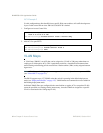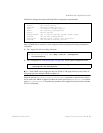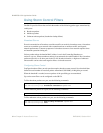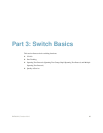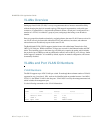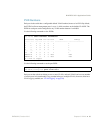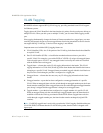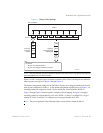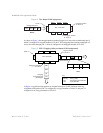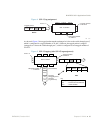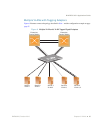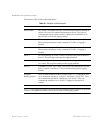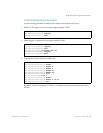
BLADEOS 6.5.2 Application Guide
90 Chapter 6: VLANs BMD00220, October 2010
VLAN Tagging
BLADEOS software supports 802.1Q VLAN tagging, providing standards-based VLAN support
for Ethernet systems.
Tagging places the VLAN identifier in the frame header of a packet, allowing each port to belong to
multiple VLANs. When you add a port to multiple VLANs, you also must enable tagging on that
port.
Since tagging fundamentally changes the format of frames transmitted on a tagged port, you must
carefully plan network designs to prevent tagged frames from being transmitted to devices that do
not support 802.1Q VLAN tags, or devices where tagging is not enabled.
Important terms used with the 802.1Q tagging feature are:
VLAN identifier (VID)—the 12-bit portion of the VLAN tag in the frame header that identifies
an explicit VLAN.
Port VLAN identifier (PVID)—a classification mechanism that associates a port with a
specific VLAN. For example, a port with a PVID of 3 (PVID =3) assigns all untagged frames
received on this port to VLAN 3. Any untagged frames received by the switch are classified
with the PVID of the receiving port.
Tagged frame—a frame that carries VLAN tagging information in the header. This VLAN
tagging information is a 32-bit field (VLAN tag) in the frame header that identifies the frame as
belonging to a specific VLAN. Untagged frames are marked (tagged) with this classification as
they leave the switch through a port that is configured as a tagged port.
Untagged frame— a frame that does not carry any VLAN tagging information in the frame
header.
Untagged member—a port that has been configured as an untagged member of a specific
VLAN. When an untagged frame exits the switch through an untagged member port, the frame
header remains unchanged. When a tagged frame exits the switch through an untagged member
port, the tag is stripped and the tagged frame is changed to an untagged frame.
Tagged member—a port that has been configured as a tagged member of a specific VLAN.
When an untagged frame exits the switch through a tagged member port, the frame header is
modified to include the 32-bit tag associated with the PVID. When a tagged frame exits the
switch through a tagged member port, the frame header remains unchanged (original VID
remains).
Note – If a 802.1Q tagged frame is received by a port that has VLAN-tagging disabled and the port
VLAN ID (PVID) is different than the VLAN ID of the packet, then the frame is dropped at the
ingress port.



